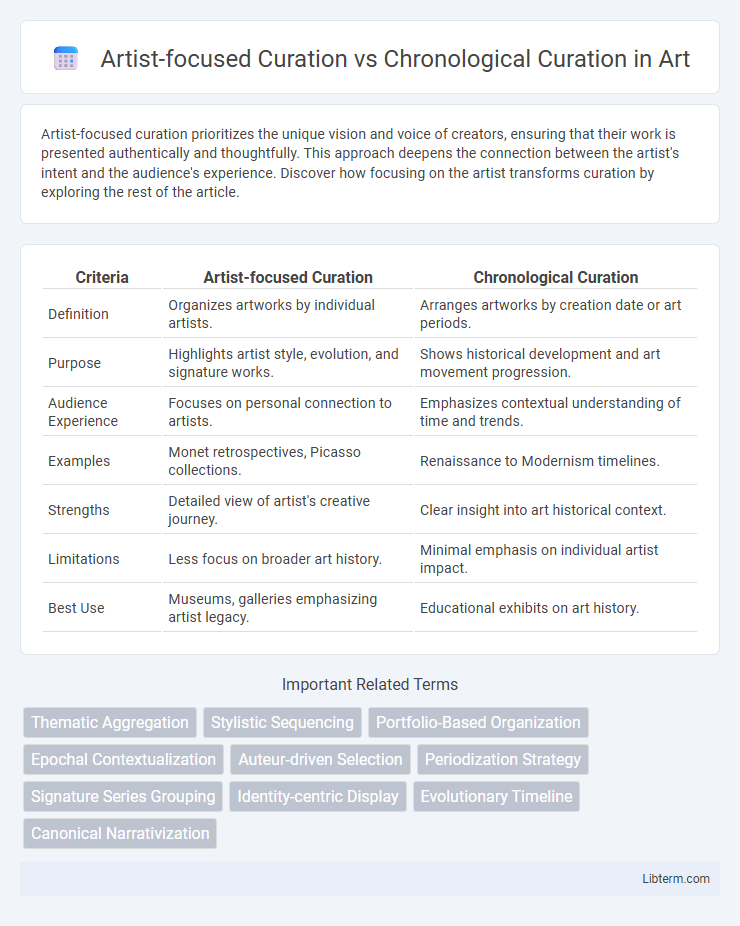Artist-focused curation prioritizes the unique vision and voice of creators, ensuring that their work is presented authentically and thoughtfully. This approach deepens the connection between the artist's intent and the audience's experience. Discover how focusing on the artist transforms curation by exploring the rest of the article.
Table of Comparison
| Criteria | Artist-focused Curation | Chronological Curation |
|---|---|---|
| Definition | Organizes artworks by individual artists. | Arranges artworks by creation date or art periods. |
| Purpose | Highlights artist style, evolution, and signature works. | Shows historical development and art movement progression. |
| Audience Experience | Focuses on personal connection to artists. | Emphasizes contextual understanding of time and trends. |
| Examples | Monet retrospectives, Picasso collections. | Renaissance to Modernism timelines. |
| Strengths | Detailed view of artist's creative journey. | Clear insight into art historical context. |
| Limitations | Less focus on broader art history. | Minimal emphasis on individual artist impact. |
| Best Use | Museums, galleries emphasizing artist legacy. | Educational exhibits on art history. |
Introduction to Art Curation Methods
Artist-focused curation emphasizes the thematic and stylistic exploration of individual artists, allowing for an in-depth understanding of their creative evolution and unique contributions within an exhibition. Chronological curation arranges artworks based on their creation dates, highlighting historical progression and contextual shifts in artistic movements over time. Both methods serve distinct educational purposes, with artist-focused curation fostering intimate artist narratives and chronological curation providing a streamlined historical framework for audience comprehension.
Defining Artist-Focused Curation
Artist-focused curation organizes content by highlighting individual artists' works and creative narratives, prioritizing thematic coherence and emotional resonance over strict timeline sequencing. This approach allows deeper exploration of an artist's evolution, styles, and contributions within cultural or artistic contexts. Emphasizing personal expression and thematic connectivity creates immersive experiences that chronological curation may overlook.
Understanding Chronological Curation
Chronological curation organizes artworks based on their creation dates, allowing viewers to trace the evolution of artistic styles and historical contexts over time. This method highlights the progression and influences between different periods, providing a temporal framework that enhances comprehension of art movements and cultural shifts. Understanding chronological curation is essential for appreciating how artists respond to and shape the artistic landscape within specific historical moments.
Historical Evolution of Curation Practices
Artist-focused curation emphasizes thematic or conceptual exploration centered around individual creators, highlighting their unique contributions and creative evolution. Chronological curation organizes artworks by time period, tracing historical developments and contextualizing artistic movements within broader cultural shifts. The historical evolution of curation practices reveals a shift from traditional chronological arrangements toward more nuanced, artist-centric approaches that foster deeper engagement and critical analysis.
Key Differences: Artist vs Chronological Curation
Artist-focused curation centers on grouping works by individual creators, emphasizing stylistic development and thematic consistency within an artist's oeuvre. Chronological curation organizes pieces by their creation date, highlighting historical context and the evolution of artistic movements over time. The key difference lies in artist curation prioritizing personal narrative and identity, while chronological curation underscores temporal progression and cultural shifts.
Impact on Audience Engagement and Experience
Artist-focused curation enhances audience engagement by fostering deeper connections with individual artists' styles and creative narratives, encouraging immersive and personalized experiences. Chronological curation provides context-driven understanding, allowing audiences to trace artistic evolution and historical influences, which enriches educational value but may dilute emotional intensity. Balancing both methods optimizes visitor interaction by combining emotional resonance with informative progression.
Advantages of Artist-Focused Curation
Artist-focused curation enhances audience engagement by highlighting the unique styles, techniques, and narratives of individual creators, fostering a deeper emotional connection with their work. This approach facilitates a comprehensive understanding of an artist's evolution, thematic consistency, and creative impact across different periods. By emphasizing personal expression over temporal sequence, artist-focused curation promotes richer storytelling and tailored exhibition experiences that resonate more strongly with diverse audiences.
Benefits of Chronological Curation
Chronological curation provides a clear historical context, allowing audiences to understand the evolution of artistic styles and movements over time. This method highlights the progression and influences between periods, offering insights into how societal changes impacted creative expression. By presenting works in a time-based sequence, chronological curation enhances educational value and facilitates a deeper appreciation of art history.
Curatorial Challenges and Considerations
Artist-focused curation emphasizes showcasing individual artists' works to highlight their creative evolution, requiring careful selection to represent diverse styles without redundancy. Chronological curation organizes works by historical period or artistic movement, demanding precise dating and contextual understanding to maintain narrative coherence. Curators must balance thematic depth with audience engagement, addressing challenges like limited provenance data and varying interpretive frameworks.
Future Trends in Art Exhibition Curation
Artist-focused curation emphasizes thematic coherence and individual artistic vision, offering deeper insights into an artist's evolution and intent, while chronological curation provides a linear historical context that highlights artistic development over time. Future trends in art exhibition curation are leaning towards hybrid models that integrate immersive technologies such as augmented reality (AR) and virtual reality (VR) to create interactive, multi-dimensional narratives that engage audiences in new ways. Data analytics and artificial intelligence (AI) tools are increasingly employed to personalize visitor experiences, enabling curators to balance artist-focused storytelling with chronological frameworks tailored to diverse audience preferences.
Artist-focused Curation Infographic

 libterm.com
libterm.com